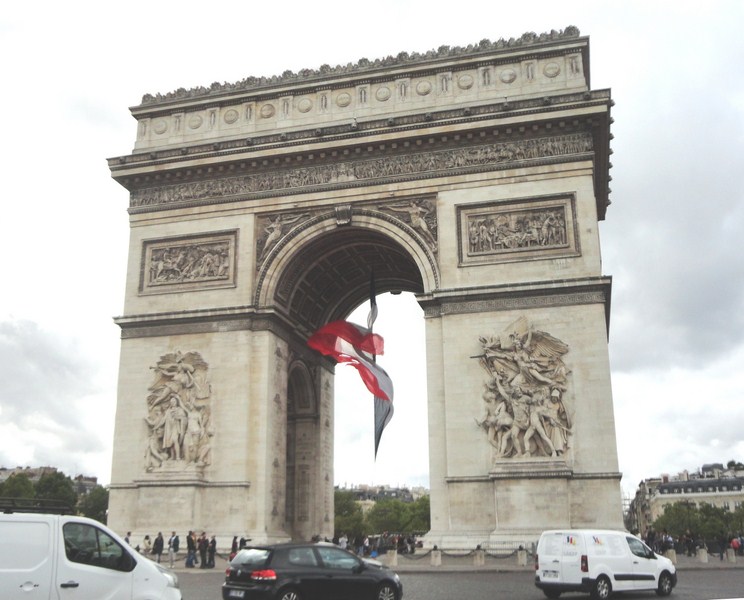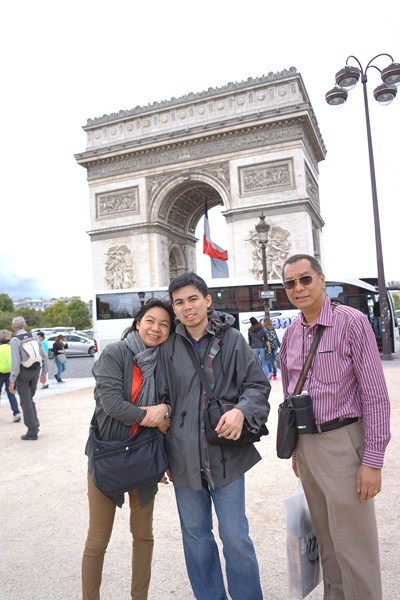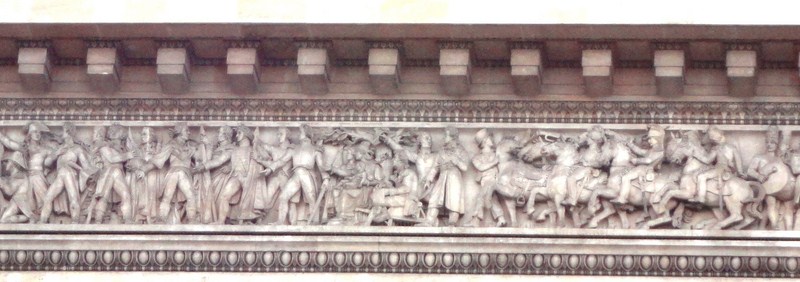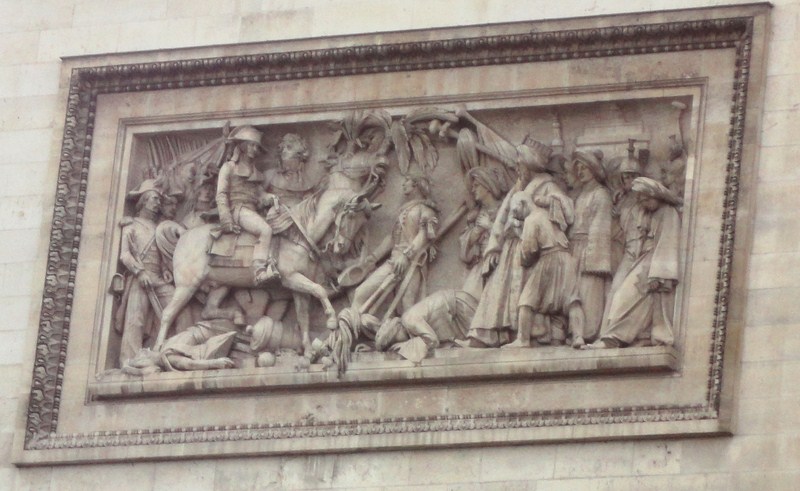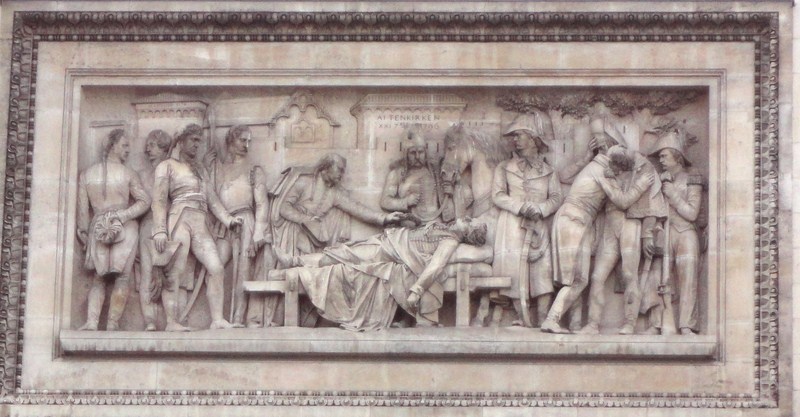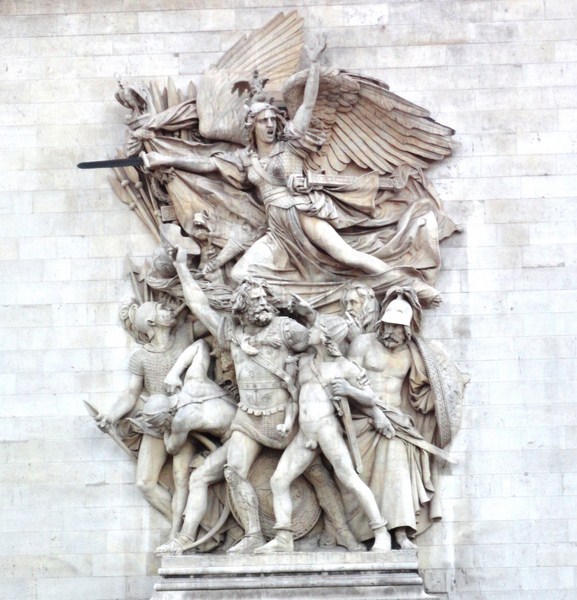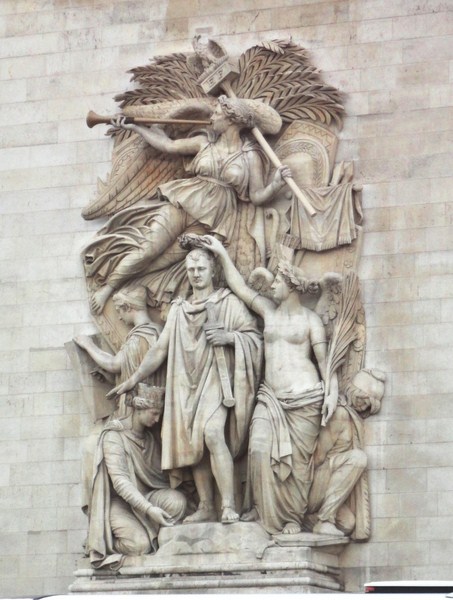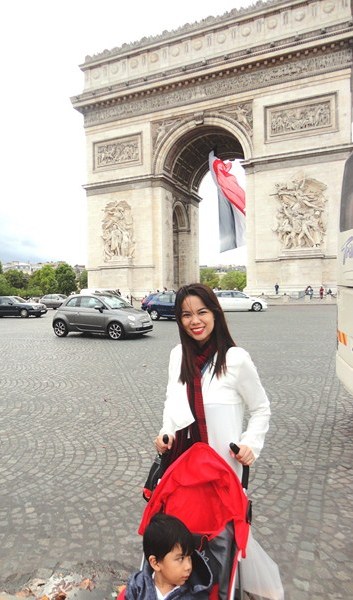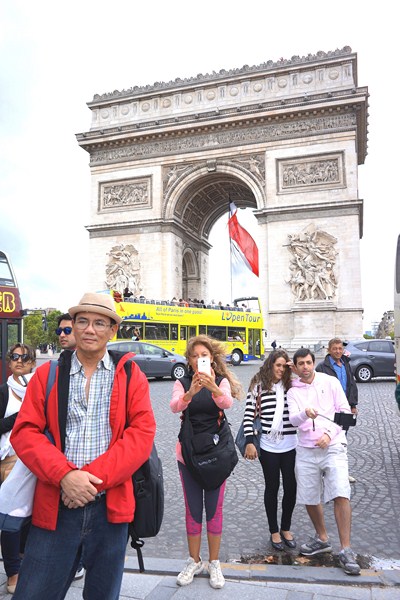Any visit to Paris is never complete without visiting the Arc de Triomphe de l’Étoile (Triumphal Arch of the Star), one of the city’s most famous monuments and the linchpin of the Axe historique (historic axis) – a sequence of monuments and grand thoroughfares on a route which runs from the courtyard of the Louvre to the Grande Arche de la Défense (built in 1982). Prior to our visit, we had seen its twice smaller cousin, the Arc de Triomphe du Carrousel, which stands west of the Louvre.
Standing at the center of the Place Charles de Gaulle (originally named Place de l’Étoile), at the western end of the Champs-Élysées, the Arc de Triomphe is located on the right bank of the Seine at the centre of a dodecagonal configuration of twelve radiating avenues. It honors those who fought and died for France during the French Revolutionary and the Napoleonic Wars.
The monument, designed by Jean Chalgrin in the astylar design, was started in 1806, after the victory at Austerlitz by Emperor Napoleon, halted during the Bourbon Restoration, and completed, between 1833 and 1836, during the reign of King Louis-Philippe.
This Neo-Classical version of the ancient Roman triumphal Arch of Titus, sets the tone for public monuments with triumphant patriotic messages, its iconographic program pits heroically nude French youths against bearded Germanic warriors in chain mail. Here are also some interesting trivia regarding the Arc de Triomphe
- Before the Arc, a three-level, elephant-shaped building , designed by French architect Charles Ribart, was proposed on this spot. The building would be entered via a spiral staircase that led up into the elephant’s underbelly. It was to have a form of air conditioning, the furniture would fold into the walls and there would be a drainage system in the elephant’s trunk. Ribart was all set to start building, but the French government ended up denying his request.
- Sadly, Napoleon never got to see the finished product as the Arc was completed 15 years after his death.
- Though designed by Jean Chalgrin, he died in 1811 and the work was taken over by Jean-Nicolas Huyot.
- The Arc de Triomphe is located at the center of 12 avenues which radiate outward.
- Although Napoleon never got to see the completed monument, he had a wooden model of the completed arch built so that, in 1810, he was able to enter Paris from the west with his new bride Archduchess Marie-Louise of Austria.
- The monument, built on such a large scale, stands 50 m. (164 ft.) high, 45 m. (148 ft.) wide and 22 m. (72 ft.) deep. The large vault is 29.19 m. (95.8 ft.) high and 14.62 m. (48.0 ft.) wide. The small vault is 18.68 m. (61.3 ft.) high and 8.44 m. (27.7 ft.) wide.
- Beneath its vault, in the chapel on the first floor, lies the Tomb of the Unknown Soldier from World War I, interred on November 10, 1920, Armistice Day . Its eternal flame burning (non-stop since November 11, 1923) in memory of the dead who were never identified (now in both world wars), was the first lit in Western and Eastern Europe since the Vestal Virgins‘ fire was extinguished in the fourth century.
- The Arc de Triomphe costed 9.3 millions French francs, a gigantic amount of money at that time.
- The Arc de Triomphe was the tallest triumphal arch in existence until the completion of the 67 m. (220 ft.) high Monumento a la Revolución in Mexico City in 1938. The slightly taller, 60 m. (197 ft.) high Arch of Triumph in Pyongyang (North Korea), completed in 1982, is modeled on the Arc de Triomphe.
- Following its construction, the Arc de Triomphe became the rallying point of French troops parading after successful military campaigns and for the annual Bastille Day Military Parade.
- After the interment of the Unknown Soldier, all military parades (including the French under Marshal Ferdinand Foch after the victory in 1919) have avoided marching through the actual arch. The route taken is up to the arch and then around its side, out of respect for the tomb and its symbolism. Both Germans (under Hitler) in 1940 and the French (under de Gaulle) and Allies in 1944 and 1945 observed this custom.
- A United States postage stamp of 1945 shows the Arc de Triomphe in the background as victorious American troops march down the Champs-Élysées and U.S. airplanes fly overhead on August 29, 1944.

Shields engraved with the names of major French victories in the French Revolution and Napoleonic wars
- In the attic above the richly sculptured frieze of soldiers are 30 shields engraved with the names of major French victories in the French Revolution and Napoleonic wars.
- The inside walls of the monument list the names of 660 people, among which are 558 French generals (those killed in battle are underlined) of the First French Empire.
- The shorter sides of the four supporting columns are inscribed with the names of the major French victories in the Napoleonic Wars.
- Two unsuccessful assassination attempts took place at the Arc de Triomphe – against Charles De Gaulle on August 22, 1962 and Jacques Chirac on July 14, 2002. Both men survived.
- Although the Arc de Triomphe is a symbol of France’s victories, German armies have marched underneath or around it on two occasions – on February 17, 1871 (after the French defeat in the Franco-Prussian War), and the Nazis on June 14,1940 during the German Occupation in World War II.
- The last time the Arc de Triomphe had a full-scale cleaning, through bleaching, was from 1965 to 1966.
- The annual Tour de France bike race finishes here.
The four main sculptural groups on each of the pillars at the base of the Arc are:
- Le Départ de 1792 (or La Marseillaise), by François Rude, and the most renowned of them all, celebrates the cause of the French First Republic during the 10 August uprising. Above the volunteers is the winged personification of Liberty. This group served as a recruitment tool in the early months of World War I and encouraged the French to invest in war loans in 1915–16.
- Le Triomphe de 1810, byJean-Pierre Cortot, celebrates the Treaty of Schönbrunn. This group features Napoleon, crowned by the goddess of Victory.
- La Résistance de 1814, by Antoine Étex, commemorates the French resistance to the Allied armies during the War of the Sixth Coalition.
- La Paix de 1815, by Antoine Étex, commemorates the Treaty of Paris, concluded in that year.
The main sculptures are not integral friezes. Rather, they are treated as independent trophies applied to the vast ashlar masonry masses. Inside the monument is a permanent exhibition, opened in February 2007, conceived by the artist Maurice Benayoun and the architect Christophe Girault.
Here are some historical trivia regarding the Arc de Triomphe:
- On December 15, 1840, Napoleon’s remains, brought back to France from Saint Helena, passed under it on their way to the Emperor’s final resting place at the Invalides.
- During the night of May 22, 1885, prior to burial in the Panthéon, the body of Victor Hugo was exposed under the Arc.
- It is said that on the day that the Battle of Verdun began in 1916, the sword carried by the Republic in the Marseillaise relief broke off. To conceal the accident and avoid any undesired ominous interpretations, the relief was immediately hidden by tarpaulins .
- On August 7, 1919,Charles Godefroy, the replacement of Jean Navarre the pilot who originally was tasked to make the flight (he died on July 10, 1919 when he crashed near Villacoublay while training for the flight), successfully flew his Nieuport biplane under the Arc in tribute to the airmen killed in the war.
- On May 31, 1961, U.S. President John F. Kennedy and First Lady Jacqueline Kennedy, accompanied by French President Charles de Gaulle, paid their respects by laying a wreath at the Tomb of the Unknown Soldier.
- On August 17, 1995, as part of a campaign of bombings, the Armed Islamic Group of Algeria exploded a bomb near the Arc de Triomphe, wounding 17 people.
Arc de Triomphe: Place Charles de Gaulle, 75008 Paris, France. Tel:+33 1 55 37 73 77. Website: www.arcdetriompheparis.com. You can climb the 284 steps to the rooftop (9.50€)..

